Kamphaeng Phet (กำแพงเพชร) is a city in Lower Northern Thailand with around 30,000 citizens. Its historical park with ruins of 14th- to 16th-century temples, city fortifications and Buddha statues is part of the UNESCO World Heritage site "Historic Town of Sukhothai and Associated Historic Towns".
In the lower north of Thailand on the bank of the Ping River, Kamphaeng Phet is about halfway between Bangkok and Chiang Mai. To its east are riverine plains while the western areas are made up of high mountains lush with forests where a number of national parks have been established.
Areas along the river bank at present-day city used to host several ancient towns which played a major role as strategic front-lines since Sukhothai was the kingdom's capital down through the times of Ayutthaya and early-Rattanakosin (Bangkok) eras. The name Kamphaeng Phet actually means "wall as hard as diamonds".
Kamphaeng Phet declined in importance and was an ordinary, smallish provincial city until the establishment of the historical park and its listing as a World Heritage site in 1991. Still, unlike its well-known neighbour Sukhothai, Kamphaeng Phet is largely ignored by tourists. This is why the city has barely any offerings geared to the needs of international travelers. Some may view this as a drawback, but those looking to experience authentic, upcountry Thailand, are coming just to the right place.
Kamphaeng Phet is a "banana capital". Its local speciality are "egg bananas" (kluai khai in Thai), whose fruit are only about 10 centimetres (4 inches) long, almost oval shaped (hence the name) and much more aromatic then the run-of-the-mill long, bent banana varieties sold in most non-tropical countries. Kamphaneng Phet Province exports bananas worth 200 million baht each year.
Kamphaeng Phet's Historical Park of temple ruins, Buddha statues, old walls and forts from the 14th to 16th centuries is part of the UNESCO World Heritage and the town's main sight. It consists of three separate parts. Admission to either the "inner district" or Khet Aranyik costs 100 baht each. A combined ticket for both sections is 150 baht. The walls, forts and the sights of Nakhon Chum can be accessed without ticket. The zones that are surrounded by fences are open daily 08:00-18:00.
- Khet Nai. The ruins of the temple district of the ancient city of Cha Kang Rao, including Wat Phra Kaeo and Wat Phra That. The Reclining Buddha of Wat Phra Kaeo is arguably the most beautiful statue in the park and one of the best depictions of the Buddha's serene smile from the Sukhothai period. The zone is surrounded by five metre high laterite walls and a 25-metre wide moat. Four of ten forts and gates are relatively well-preserved and can be visited.
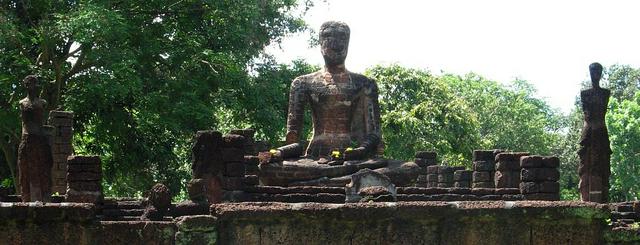
- Khet Aranyik. Thailand's Buddhist clergy was divided into "town monks" who studied, taught and performed ceremonies for the believers, and "forest monks" who went into retreat, dedicated to meditation and asceticism. The bigger part of the historical park, covered with light forest, consists of the hermitage ruins of the latter group. Thanks to the canopy of leaves, it is very pleasant to visit on foot or by bicycle (can be rented by the main entrance). Its main sites are Wat Chang Rop (with its remarkable chedi that is surrounded by 68 stucco elephant figures), Wat Phra Non (with a relatively well-preserved chedi and remains of a Reclining Buddha statue), Wat Phra Si Iriyabot (with the park's only surviving, nine metre high standing Buddha statue). Next to the main entrance to this zone is also the park administration.
- Mueang Nakhon Chum. Kamphaeng Phet/Cha Kang Rao's sister city on the opposite bank of the Ping River is even older. Its fortification and temple ruins are however in a worse state of preservation. Unlike on the other bank, there is no actual park with fence, cashier, and trim paths, but the ruins are simply dispersed among the landscape, widely ignored by locals and tourists alike. The only historic temple that is still in use, is Wat Phra Borommathat (see below, in the temples section).
Khet Nai. The ruins of the temple district of the ancient city of Cha Kang Rao, including Wat Phra Kaeo and Wat Phra That. The Reclining Buddha of Wat Phra Kaeo is arguably the most beautiful statue in the park and one of the best depictions of the Buddha's serene smile from the Sukhothai period. The zone is surrounded by five metre high laterite walls and a 25-metre wide moat. Four of ten forts and gates are relatively well-preserved and can be visited.
Khet Aranyik. Thailand's Buddhist clergy was divided into "town monks" who studied, taught and performed ceremonies for the believers, and "forest monks" who went into retreat, dedicated to meditation and asceticism. The bigger part of the historical park, covered with light forest, consists of the hermitage ruins of the latter group. Thanks to the canopy of leaves, it is very pleasant to visit on foot or by bicycle (can be rented by the main entrance). Its main sites are Wat Chang Rop (with its remarkable chedi that is surrounded by 68 stucco elephant figures), Wat Phra Non (with a relatively well-preserved chedi and remains of a Reclining Buddha statue), Wat Phra Si Iriyabot (with the park's only surviving, nine metre high standing Buddha statue). Next to the main entrance to this zone is also the park administration.
Mueang Nakhon Chum. Kamphaeng Phet/Cha Kang Rao's sister city on the opposite bank of the Ping River is even older. Its fortification and temple ruins are however in a worse state of preservation. Unlike on the other bank, there is no actual park with fence, cashier, and trim paths, but the ruins are simply dispersed among the landscape, widely ignored by locals and tourists alike. The only historic temple that is still in use, is Wat Phra Borommathat (see below, in the temples section).
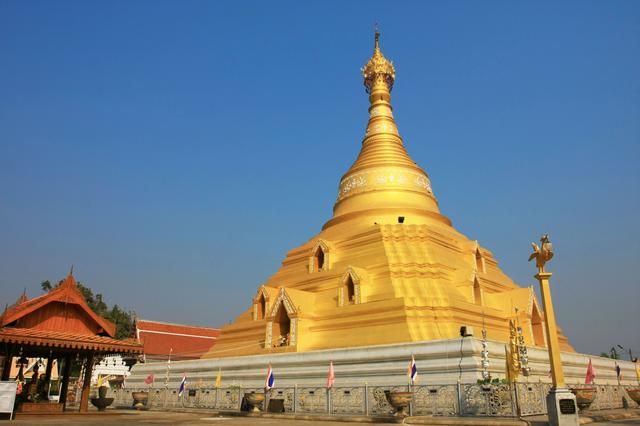
- Wat Khu Yang, Th. Wichit 1. Old temple in the town centre whose history dates to c. 1600. The present buildings date from the 1850s. Notable is the ho trai, i.e., the monastery's library, a traditional wooden house standing on stilts amid a water ditch. Its roof is covered with characteristic fish-scale shaped tiles. The ubosot is nice to look at too, especially at dusk when the colourful glass elements of the elaborately decorated pediment shimmer.
- Wat Phra Borommathat, Nakhon Chum. This temple is one of the oldest in Kamphaeng Phet (its history probably dates back to the 14th century) and the only ancient monastery of the historical park that is not a ruin but still active. Its most visible feature is the tall, gold-covered pagoda in Burmese Mon style that can be seen from afar. Originally, the chedi was Sukhothai-style, but it was redesigned during a renovation from 1870 to 1907, sponsored by a rich timber merchant. The temple compound also hosts the "Nakhon Chum cultural centre" in a traditional teak building, with a collection of all kinds of antique objects, that however lack explanations (at least in English).
- Wat Sawang Arom, Nakhon Chum (West of the Suan Mak canal, some 800 m off the Route 1/Asian Highway. Turn left at the Esso gas pump before the bridge, at the end of the road turn right through the underpass, then left, past the small market, after 450 m left again, across the bridge, and another 100 m to the temple entrance. Old temple with a beautiful, three metre high, Chiang Saen-style Buddha statue in the "calling the earth to witness" posture.
Wat Khu Yang, Th. Wichit 1. Old temple in the town centre whose history dates to c. 1600. The present buildings date from the 1850s. Notable is the ho trai, i.e., the monastery's library, a traditional wooden house standing on stilts amid a water ditch. Its roof is covered with characteristic fish-scale shaped tiles. The ubosot is nice to look at too, especially at dusk when the colourful glass elements of the elaborately decorated pediment shimmer.
Wat Phra Borommathat, Nakhon Chum. This temple is one of the oldest in Kamphaeng Phet (its history probably dates back to the 14th century) and the only ancient monastery of the historical park that is not a ruin but still active. Its most visible feature is the tall, gold-covered pagoda in Burmese Mon style that can be seen from afar. Originally, the chedi was Sukhothai-style, but it was redesigned during a renovation from 1870 to 1907, sponsored by a rich timber merchant. The temple compound also hosts the "Nakhon Chum cultural centre" in a traditional teak building, with a collection of all kinds of antique objects, that however lack explanations (at least in English).
Wat Sawang Arom, Nakhon Chum (West of the Suan Mak canal, some 800 m off the Route 1/Asian Highway. Turn left at the Esso gas pump before the bridge, at the end of the road turn right through the underpass, then left, past the small market, after 450 m left again, across the bridge, and another 100 m to the temple entrance. Old temple with a beautiful, three metre high, Chiang Saen-style Buddha statue in the "calling the earth to witness" posture.
- Kamphaeng Phet National Museum, Th Pin Damri, +66 55 711570. W-Su, 09:00-16:30. Exhibition of bronze sculptures and pottery from different periods of Thai art and Mon art. The highlight is an early 16th-century bronze Shiva statue. Its head and hands were cut off in 1886 by a German trader who tried to smuggle them to Europe. They were however confiscated before he could send them abroad and were reunited with the torso. A replica was then made under orders of King Rama V, given to the German crown prince and is now exhibited at the Berlin Museum of Asian Art. 100 baht.
- Kamphaeng Phet Chaloemphrakiat Museum, +66 55 722341-2. Daily, 09:00-16:30. Elegant replicas of traditional Thai houses, hosting an exhibition about local and regional history and lifestyle. 10 baht; multimedia room 250 baht per group.
- Next to the Thai House Museum is a banana orchard, officially named the "Centre for Collection of Banana Varieties" (ศูนย์รวมสายพันธุ์กล้วย), growing banana plants of more than 150 different breeds.
Kamphaeng Phet National Museum, Th Pin Damri, +66 55 711570. W-Su, 09:00-16:30. Exhibition of bronze sculptures and pottery from different periods of Thai art and Mon art. The highlight is an early 16th-century bronze Shiva statue. Its head and hands were cut off in 1886 by a German trader who tried to smuggle them to Europe. They were however confiscated before he could send them abroad and were reunited with the torso. A replica was then made under orders of King Rama V, given to the German crown prince and is now exhibited at the [[Berlin]] Museum of Asian Art. 100 baht.
Kamphaeng Phet Chaloemphrakiat Museum, +66 55 722341-2. Daily, 09:00-16:30. Elegant replicas of traditional Thai houses, hosting an exhibition about local and regional history and lifestyle. 10 baht; multimedia room 250 baht per group.
- San Lak Mueang, Th. Ratchadamnoen 2 (At the corner of the historical park's "inner district", on the road to Sukhothai. Shrine that houses the symbolic navel of the city which according to the locals' belief is home to the city's guardian spirits.
- Shiva shrine. Original place of the Shiva statue that now is kept at the National Museum, there is a replica where locals bring their offerings, asking the deity for blessing of themselves, their families and pets.
- Clock tower. Landmark and central orientation point. It is made of laterite, thus referring to the ancient monuments of the historical park, that consist of the same material. With its castle-like shape and crenelations, it is also a nod to the city's name: "diamond wall". The bodhi (sacred fig) tree on the other side of the roundabout is used by locals as a meeting point.
San Lak Mueang, Th. Ratchadamnoen 2 (At the corner of the historical park's "inner district", on the road to Sukhothai. Shrine that houses the symbolic navel of the city which according to the locals' belief is home to the city's guardian spirits.
Shiva shrine. Original place of the Shiva statue that now is kept at the National Museum, there is a replica where locals bring their offerings, asking the deity for blessing of themselves, their families and pets.
Clock tower. Landmark and central orientation point. It is made of laterite, thus referring to the ancient monuments of the historical park, that consist of the same material. With its castle-like shape and crenelations, it is also a nod to the city's name: "diamond wall". The bodhi (sacred fig) tree on the other side of the roundabout is used by locals as a meeting point.
- Stroll, jog or cycle along the palm-lined waterside promenade. on the bank of Ping River (Rim Ping, ริมปิง); enjoy a foot massage (200 baht/hr); relax at Sirichit Park (สิริจิตอุทยาน) which offers free outdoor gym machines, a children's swimming pool, a tennis court and lots of stalls selling snacks and refreshments. You can cross the bridge to the quaint little island in the middle of the river (Ko Klang Maenam Ping, เกาะกลางแม่น้ำปิง).
- Traditional Thai massage "Pa Phim", Rachavitee Rd 1 (200 m west of Three J Guesthouse, next to Suea Yim Coffee Club. Owner is an alumna of the reputable Wat Pho massage school in Bangkok. 2 hr for 200 baht.
- Nop Phra Len Phleng festival on Makha Bucha, i.e., full moon in late-February or early-March, commemorates the donation of a Buddha relic to the city of Nakhon Chum (one of the precursors of Kamphaeng Phet) by king Li Thai in 1357. An inscription which describes a procession in honour of this relic is one of the oldest documents of local history. The tradition was revived in 1983 and since then a great pageant is held annually. The city is decorated several days beforehand. Nop Phra means to 'pay respect to the Buddha', Len means 'play' and Phleng is 'song'. This sums up the programme of this festival pretty well: apart from the religious parade (with attendees in historic costumes), cultural performances like dance and plays are staged. Moreover there is a light and sound show in the historical park and a large fair where regional products are peddled.
- Thai kite festival Cha-kang-rao (February to March), traditional kite competition at Sirichit Park
- Banana Festival on ten days around Sat Thai, i.e., new moon in late-September, celebrating and promoting the province's best-known product. There are different parades and contests, including the selection of a banana queen, and of course lots of opportunities to taste bananas and krayasat, a local sweet made from puffed rice, toasted sesame, peanuts and sugar.
- Loi Krathong on November's full moon, like in most Thai cities the festival of lights in honour of the river goddess is celebrated in Kamphaeng Phet, too. There is a parade with floats shaped like oversized krathong (i.e., decorated floats made from banana wood and leaves), a competition for the most beautiful krathong as well as the selection of a beauty queen and different cultural programmes. Most activities are centered around Sirichit Park at the bank of Ping River.
- Food fair and noodle festival (1-3 December), Noodle dishes are the favourite food of many locals, so an annual fair was established around this theme with many food stalls offering local products around Sirichit Park.
Nop Phra Len Phleng festival on Makha Bucha, i.e., full moon in late-February or early-March, commemorates the donation of a Buddha relic to the city of Nakhon Chum (one of the precursors of Kamphaeng Phet) by king Li Thai in 1357. An inscription which describes a procession in honour of this relic is one of the oldest documents of local history. The tradition was revived in 1983 and since then a great pageant is held annually. The city is decorated several days beforehand. Nop Phra means to 'pay respect to the Buddha', Len means 'play' and Phleng is 'song'. This sums up the programme of this festival pretty well: apart from the religious parade (with attendees in historic costumes), cultural performances like dance and plays are staged. Moreover there is a light and sound show in the historical park and a large fair where regional products are peddled.
Thai kite festival Cha-kang-rao (February to March), traditional kite competition at Sirichit Park
Banana Festival on ten days around Sat Thai, i.e., new moon in late-September, celebrating and promoting the province's best-known product. There are different parades and contests, including the selection of a banana queen, and of course lots of opportunities to taste bananas and krayasat, a local sweet made from puffed rice, toasted sesame, peanuts and sugar.
Loi Krathong on November's full moon, like in most Thai cities the festival of lights in honour of the river goddess is celebrated in Kamphaeng Phet, too. There is a parade with floats shaped like oversized krathong (i.e., decorated floats made from banana wood and leaves), a competition for the most beautiful krathong as well as the selection of a beauty queen and different cultural programmes. Most activities are centered around Sirichit Park at the bank of Ping River.
Food fair and noodle festival (1-3 December), Noodle dishes are the favourite food of many locals, so an annual fair was established around this theme with many food stalls offering local products around Sirichit Park.
Stroll, jog or cycle along the palm-lined waterside promenade. on the bank of Ping River (Rim Ping, ริมปิง); enjoy a foot massage (200 baht/hr); relax at Sirichit Park (สิริจิตอุทยาน) which offers free outdoor gym machines, a children's swimming pool, a tennis court and lots of stalls selling snacks and refreshments. You can cross the bridge to the quaint little island in the middle of the river (Ko Klang Maenam Ping, เกาะกลางแม่น้ำปิง).
Traditional Thai massage "Pa Phim", Rachavitee Rd 1 (200 m west of Three J Guesthouse, next to Suea Yim Coffee Club. Owner is an alumna of the reputable Wat Pho massage school in Bangkok. 2 hr for 200 baht.
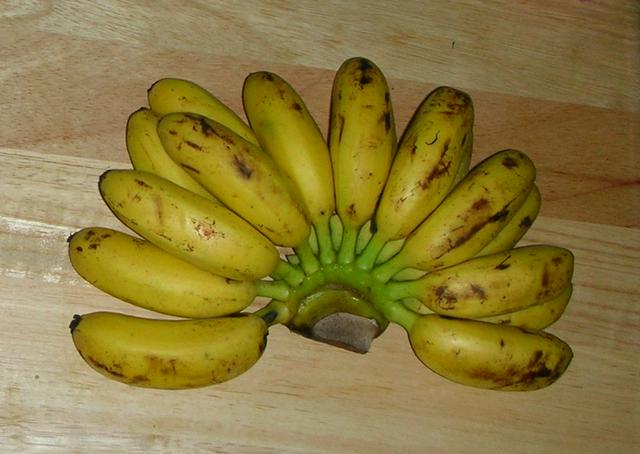
-TyXOo.medium.jpg) Kamphaeng Phet is famous for a small, round, sweet and aromatic banana variety called "egg bananas" (Thai: kluai khai).
Kamphaeng Phet is famous for a small, round, sweet and aromatic banana variety called "egg bananas" (Thai: kluai khai).
- Big C Supercenter, 613/1 Charoensuk Rd. Large shopping mall with a variety of shops, system catering and a cinema.
- Tesco Lotus, Bamrungrat Rd Soi 4. Western-style supermarket with a little mall of a few individual shops and a KFC branch.
- Main daytime market. Wet market selling fresh food and ready-to-eat dishes as well as craft products.
- Talat Ton Pho, Thesa Rd 1 Soi 2 (Near the bodhi tree. Mainly food, including ready-to-eat dishes.
- Night market. Great variety of food, including ready-to-eat dishes.
- There are several 7-Elevens around the town, one of them next to the main roundabout (next to bodhi tree and clock tower).
- Banana market, Tambon Ang Thong (On both sides of Hwy 1/Asian Highway, about 14 km south of town. Dozens of stalls selling fresh bananas (ripe or green), fried bananas, bananas baked in honey, and rattan products.
The city has branches of all Thai banks. ATMs can also be found at the bus terminal and Big C.
Big C Supercenter, 613/1 Charoensuk Rd. Large shopping mall with a variety of shops, system catering and a cinema.
Tesco Lotus, Bamrungrat Rd Soi 4. Western-style supermarket with a little mall of a few individual shops and a KFC branch.
Main daytime market. Wet market selling fresh food and ready-to-eat dishes as well as craft products.
Talat Ton Pho, Thesa Rd 1 Soi 2 (Near the bodhi tree. Mainly food, including ready-to-eat dishes.
Night market. Great variety of food, including ready-to-eat dishes.
Banana market, Tambon Ang Thong (On both sides of Hwy 1/Asian Highway, about 14 km south of town. Dozens of stalls selling fresh bananas (ripe or green), fried bananas, bananas baked in honey, and rattan products.
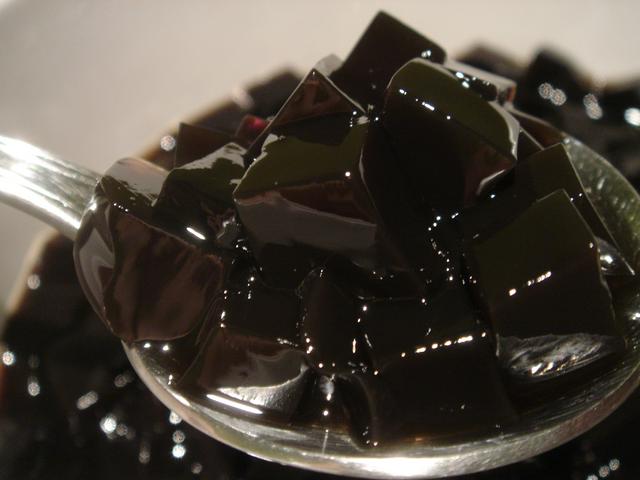
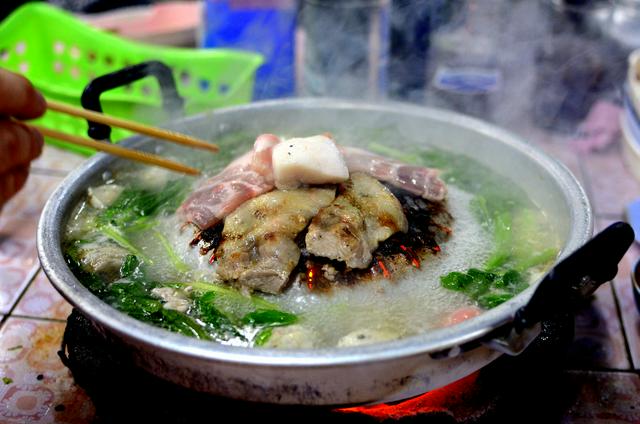 Apart from the local "egg bananas", local specialties include "grass jelly" (Chao Kuai, เฉาก๊วย), served on ice as a dessert or refreshing snack.
Apart from the local "egg bananas", local specialties include "grass jelly" (Chao Kuai, เฉาก๊วย), served on ice as a dessert or refreshing snack.
There are dozens of small restaurants, but only very few are attuned to foreign guests. English menus are pretty rare. The night market (starting 17:00) is particularly good for cheap and varied eats, having countless stalls serving ready-to-eat or made-to-order dishes. It is on Tesa 1 between Bamrungrat and Soi 14. During the day Ton Pho Market between Tesa 1 and Rachadamnoen, first soi south from Kamphaengphet/101 is a good bet for food.
Another popular meal is Mu kratha (หมูกระทะ), offered at several open-air restaurants in town. Guests come in groups and take different ingredients (mostly pork) from a buffet to cook them on a small barbecue or in a hot pot at their tables (somewhat comparable to a raclette or fondue meal).
While a handful of restaurants are open until around midnight much of the town shuts up pretty early, between 20:00 and 21:00; even the night market is winding down by that time. Bear this in mind when planning your dinner.
- Bami Chakangrao, Ratchadamnoen 1 Rd (Sign only in Thai script, recognisable by the green shield and light-green awning. Simple, but popular restaurant, mainly serving yellow noodle dishes (e.g., with tom yum soup) and grilled pork skewers. Video clip presenting the restaurant (Thai).
- Kai Yang Phi Paeo, Soi Ratchawithi 5 (Only Thai signage, +66 55 717413. Daily, 08:00-17:00. Offers delicious grilled chicken, som tam and other spicy Northeastern Thai dishes. There is an air conditioned and a non-AC room. Video clip (Thai).
- Khrua Rim Khlong, Soi Suk Sakun, Nakhon Chum (Off Hwy 1 to Tak; turn left to the byroad at the Esso filling station before the bridge, at the end of the road turn left again. Rustic open-air restaurant in a garden by the riverside, serving mainly dishes with freshwater fish.
- Supha Phochana, 18-20 Soi 8 Ratchadamnoen 1 Rd (Sign with golden Thai letters on a red background. Simple, very popular restaurant for authentic Thai food. Specialty of the house is Tom Lueat Moo (soup with clotted pig blood).
- Suphap Phat Thai Nakhon Chum, Nakhon Chum market (on the opposite side of the river. Small restaurant and takeaway, supposedly making (according to locals) the best pad Thai.
Bami Chakangrao, Ratchadamnoen 1 Rd (Sign only in Thai script, recognisable by the green shield and light-green awning. Simple, but popular restaurant, mainly serving yellow noodle dishes (e.g., with tom yum soup) and grilled pork skewers. Video clip presenting the restaurant (Thai).
Kai Yang Phi Paeo, Soi Ratchawithi 5 (Only Thai signage, +66 55 717413. Daily, 08:00-17:00. Offers delicious grilled chicken, som tam and other spicy Northeastern Thai dishes. There is an air conditioned and a non-AC room. Video clip (Thai).
Khrua Rim Khlong, Soi Suk Sakun, Nakhon Chum (Off Hwy 1 to Tak; turn left to the byroad at the Esso filling station before the bridge, at the end of the road turn left again. Rustic open-air restaurant in a garden by the riverside, serving mainly dishes with freshwater fish.
Supha Phochana, 18-20 Soi 8 Ratchadamnoen 1 Rd (Sign with golden Thai letters on a red background. Simple, very popular restaurant for authentic Thai food. Specialty of the house is Tom Lueat Moo (soup with clotted pig blood).
Suphap Phat Thai Nakhon Chum, Nakhon Chum market (on the opposite side of the river. Small restaurant and takeaway, supposedly making (according to locals) the best pad Thai.
- Fourest, 55 Ratchadamnoen 2 Rd (At the south gate of Historical Park (Khet Aranyik), opposite Wat Phra Kaeo, +66 55 854907. Daily, 11:00-23:00. Restaurant and café with a large garden at the edge of Historical Park. Serves European beers. Live music evenings.
- Kitti Restaurant, 287 Wichit 2 Rd (Corner of Bamrungrat Rd; round building with glass door, Chinese lanterns, red sign with gold lettering, +66 55 711229, +66 55 713320. Daily, 09:00-22:00. Large and long-standing Chinese restaurant with diverse selection of dishes. A little expensive.
- Mae Ping Riverside, 50/1 Moo 2, Nakhon Chum (On the opposite bank of Ping River. Large choice in dishes, mainly (but not only) freshwater fish; draught beer; seats directly on the riverbank with a beautiful view of the town; frequently live music in the evening.
- Oasis Bar & Restaurant, 143-3 Moo 10, Nakhon Chum (Six km outside the city centre; 1.2 km off Hwy 1 to Tak—signposted, +66 81 8947160. German owner and chef; German and Thai dishes, burger, pizza, lasagne; various German beers; meeting place of Western expats.
- Sathanee Steak, Ratchadamnoen 1 Rd (Near night market and Navarat Hotel. Quaint restaurant and café with antiques in the American 1920s to '50s style. As its name implies, mostly steaks are served. Video.
- Tori Japanese Restaurant, 168/9 Rat Ruam Chai Rd (On the ring road surrounding the city centre; recognisable by Japanese-style decoration and lettering. Noon-14:00 and 16:00-21:00, closed Tu. Small Japanese restaurant, serving sushi, ramen and the like.
- There are branches of the usual chains (KFC, MK, Pizza Company, etc.) at Big C Supercenter.
Fourest, 55 Ratchadamnoen 2 Rd (At the south gate of Historical Park (Khet Aranyik), opposite Wat Phra Kaeo, +66 55 854907. Daily, 11:00-23:00. Restaurant and café with a large garden at the edge of Historical Park. Serves European beers. Live music evenings.
Kitti Restaurant, 287 Wichit 2 Rd (Corner of Bamrungrat Rd; round building with glass door, Chinese lanterns, red sign with gold lettering, +66 55 711229, +66 55 713320. Daily, 09:00-22:00. Large and long-standing Chinese restaurant with diverse selection of dishes. A little expensive.
Mae Ping Riverside, 50/1 Moo 2, Nakhon Chum (On the opposite bank of Ping River. Large choice in dishes, mainly (but not only) freshwater fish; draught beer; seats directly on the riverbank with a beautiful view of the town; frequently live music in the evening.
Oasis Bar & Restaurant, 143-3 Moo 10, Nakhon Chum (Six km outside the city centre; 1.2 km off Hwy 1 to Tak—signposted, +66 81 8947160. German owner and chef; German and Thai dishes, burger, pizza, lasagne; various German beers; meeting place of Western expats.
Sathanee Steak, Ratchadamnoen 1 Rd (Near night market and Navarat Hotel. Quaint restaurant and café with antiques in the American 1920s to '50s style. As its name implies, mostly steaks are served. Video.
Tori Japanese Restaurant, 168/9 Rat Ruam Chai Rd (On the ring road surrounding the city centre; recognisable by Japanese-style decoration and lettering. Noon-14:00 and 16:00-21:00, closed Tu. Small Japanese restaurant, serving sushi, ramen and the like.
Like any Thai town with more than a handful of people, Kamphaeng Phet has been overrun with cafes serving a wide range of espresso-based beverages. Most also have a selection of cakes.
- About Coffee by Dao, Vichit 1 Rd, +66 55 712095. 08:00-23:00. Cozy café with fresh coffee and espresso-derivatives; free Wi-Fi. About halfway between downtown and National Museum/Historical Park.
- Coffee Mania, Charoensuk Rd (Corner of Thesaban 1; on the right side of the yellow filling station. Cozy, retro-styled café; offers espresso, cappuccino, frappes, etc. Owner speaks English.
- Cake Pond. 07:00-?. Bakery, coffee shop. Lots of breads, mini pizzas and cake options at reasonable prices. Two muffins for 30 baht, tasty and a good deal. Air-con. Espresso 35 baht.
- Coffee Today. A popular coffee shop. Cappuccino at 50 baht, selection of sweet snacks, Wi-Fi. On the street corner opposite the town fountain.
There are at least three cafes on Wichien/Rachavitee. Starting from Rachadumnoen heading towards 3J Guesthouse, look on the south side of the road...
- Ba-Gan Tim. 09:00-21:00. Identifiable by the cute cow sign next to the chalk board. Serves cakes. Has A/C. Espresso 30 baht.
- In Coffee. A small stall affair with only a couple of tables. espresso 25 baht.
- Coffee Club. 08:00-18:00. Comfortable sofas and some great coffee. They also provide a free pot of green tea with each cup of coffee. Has A/C and Wi-Fi, and serves cakes. Espresso 30 baht.
Vijit 2 has two cafes within 200 m heading south from Wichien, the first in a bookshop. (09:00-20:00, espresso, 30 baht, air-con, free Wi-Fi) and the next, Sugar Cane Coffee. (espresso, 40 baht, air-con, free Wi-Fi) about 50 m further on. Both are on the east side of the street and also serve cakes.
About Coffee by Dao, Vichit 1 Rd, +66 55 712095. 08:00-23:00. Cozy café with fresh coffee and espresso-derivatives; free Wi-Fi. About halfway between downtown and National Museum/Historical Park.
Coffee Mania, Charoensuk Rd (Corner of Thesaban 1; on the right side of the yellow filling station. Cozy, retro-styled café; offers espresso, cappuccino, frappes, etc. Owner speaks English.
Cake Pond. 07:00-?. Bakery, coffee shop. Lots of breads, mini pizzas and cake options at reasonable prices. Two muffins for 30 baht, tasty and a good deal. Air-con. Espresso 35 baht.
Coffee Today. A popular coffee shop. Cappuccino at 50 baht, selection of sweet snacks, Wi-Fi. On the street corner opposite the town fountain.
Ba-Gan Tim. 09:00-21:00. Identifiable by the cute cow sign next to the chalk board. Serves cakes. Has A/C. Espresso 30 baht.
In Coffee. A small stall affair with only a couple of tables. espresso 25 baht.
Coffee Club. 08:00-18:00. Comfortable sofas and some great coffee. They also provide a free pot of green tea with each cup of coffee. Has A/C and Wi-Fi, and serves cakes. Espresso 30 baht.
Vijit 2 has two cafes within 200 m heading south from Wichien, the first in a bookshop. (09:00-20:00, espresso, 30 baht, air-con, free Wi-Fi) and the next, Sugar Cane Coffee. (espresso, 40 baht, air-con, free Wi-Fi) about 50 m further on. Both are on the east side of the street and also serve cakes.
Vijit 2 has two cafes within 200 m heading south from Wichien, the first in a bookshop. (09:00-20:00, espresso, 30 baht, air-con, free Wi-Fi) and the next, Sugar Cane Coffee. (espresso, 40 baht, air-con, free Wi-Fi) about 50 m further on. Both are on the east side of the street and also serve cakes.
- 3 TIME Pub & Restaurant, 4-6 Prachahansa Rd. Daily, 18:00-02:00. Hip bar (at least by the standards of a provincial town), live music.
- Banana Pub. Night club in the basement of Phet Hotel with a stage for live music and go-go dance.
- Common Coffee, 141 Thesa 1 Rd (Next to Chakungrao Hotel. Daily, 10:00-23:00. Small café and cocktail bar, large variety of imported beer in bottles. Cocktails 129+ baht.
- Eagle Pub, 61 Bamrungrat Rd (Corner of Charoensuk Soi 2.
- Rong Tiam, Thesa 1 Soi 9 (Alley between Thanon Thesa 1 and Ratchadamnoen 1; old wooden house with red lanterns and Chang beer sign; name plate is only in Thai. Cozy and relaxed pub; live music on some days, starting around 21:00.
3 TIME Pub & Restaurant, 4-6 Prachahansa Rd. Daily, 18:00-02:00. Hip bar (at least by the standards of a provincial town), live music.
Banana Pub. Night club in the basement of Phet Hotel with a stage for live music and go-go dance.
Common Coffee, 141 Thesa 1 Rd (Next to Chakungrao Hotel. Daily, 10:00-23:00. Small café and cocktail bar, large variety of imported beer in bottles. Cocktails 129+ baht.
Eagle Pub, 61 Bamrungrat Rd (Corner of Charoensuk Soi 2.
Rong Tiam, Thesa 1 Soi 9 (Alley between Thanon Thesa 1 and Ratchadamnoen 1; old wooden house with red lanterns and Chang beer sign; name plate is only in Thai. Cozy and relaxed pub; live music on some days, starting around 21:00.
- Thailand Post, Chakangrao Post Office, Thanon Thesa 1 (300 m east of the clock tower/bodhi tree roundabout.
Thailand Post, Chakangrao Post Office, Thanon Thesa 1 (300 m east of the clock tower/bodhi tree roundabout.
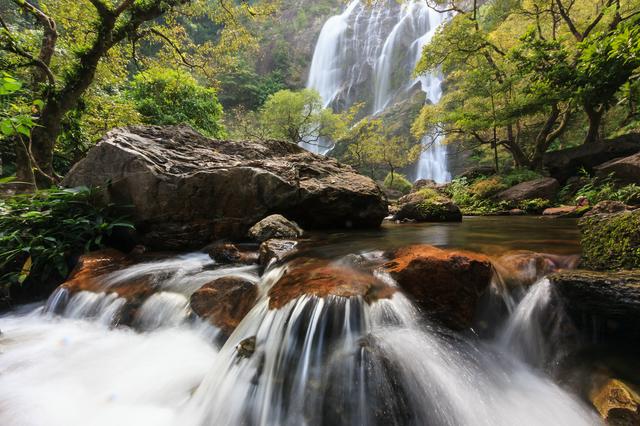
- Hot springs of Phra Ruang, Tambon Lan Dok Mai (25 km north of the main town: Follow Hwy 101 north (towards Sukhothai) out of Kamphaeng Phet for 13 km, then turn left and 12 km up this road you'll come upon the springs.. Admission 30 baht, private cabin for bathing 50 baht.
- Khlong Lan National Park and waterfalls, Amphoe Khlong Lan (60 km southwest of Kamphaeng Phet; songthaeos from Kamphaeng Phet market to Khlong Lan village, hitchhike the last 6 km to the national park; or go by car, motorbike or chartered minivan, "Khlong Lan" or "Khlong Lan National Park" is signposted in Roman script from Hwy 1/Asian Hwy.
- Mae Wang National Park, Amphoe Pang Sila Thong (65 km southwest of Kamphaeng Phet; only by car, motorbike or chartered minivan.
Hot springs of Phra Ruang, Tambon Lan Dok Mai (25 km north of the main town: Follow Hwy 101 north (towards Sukhothai) out of Kamphaeng Phet for 13 km, then turn left and 12 km up this road you'll come upon the springs.. Admission 30 baht, private cabin for bathing 50 baht.
Khlong Lan National Park and waterfalls, Amphoe Khlong Lan (60 km southwest of Kamphaeng Phet; songthaeos from Kamphaeng Phet market to Khlong Lan village, hitchhike the last 6 km to the national park; or go by car, motorbike or chartered minivan, "Khlong Lan" or "Khlong Lan National Park" is signposted in Roman script from Hwy 1/Asian Hwy.
Mae Wang National Park, Amphoe Pang Sila Thong (65 km southwest of Kamphaeng Phet; only by car, motorbike or chartered minivan.
- Tak, 70 km northwest, 1:10 hr by Chiang Mai-bound buses or songthaew (half-hourly), in Tak you can transfer to Mae Sot at the Burmese border
- Sukhothai, 80 km north, 1½ hours by bus or songthaew – the former Siamese capital is another, even more comprehensive historic town from the same era as Kamphaeng Phet
- Phitsanulok, 100 km northeast, 2–3 hours by local bus – trade city and transportation hub, several temples and a huge golden Buddha statue
- Nakhon Sawan, 120 km southeast, 1:45 hr by Bangkok-bound buses – near Bueng Boraphet wetland and bird reserve, notable for its many water lilies
- Phichit, 120 km east – the town is the setting of a legend about the crocodile king, illustrated by a crocodile park
